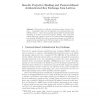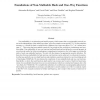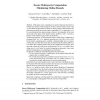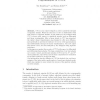ASIACRYPT
2009
Springer
14 years 6 months ago
2009
Springer
Abstract. We describe a public-key encryption scheme based on lattices — specifically, based on the hardness of the learning with error (LWE) problem — that is secure against ...
ASIACRYPT
2009
Springer
14 years 6 months ago
2009
Springer
A universally composable (UC) blind signature functionality requres users to commit to the message to be blindly signed. It is thereby impossible to realize in the plain model. Th...
ASIACRYPT
2009
Springer
14 years 6 months ago
2009
Springer
ASIACRYPT
2009
Springer
14 years 6 months ago
2009
Springer
Computational puzzles are mildly difficult computational problems that require resources (processor cycles, memory, or both) to solve. Puzzles have found a variety of uses in secu...
ASIACRYPT
2009
Springer
14 years 6 months ago
2009
Springer
Non-malleability is an interesting and useful property which ensures that a cryptographic protocol preserves the independence of the underlying values: given for example an encryp...
ASIACRYPT
2009
Springer
14 years 6 months ago
2009
Springer
Multi-party secure computations are general important procedures to compute any function while keeping the security of private inputs. In this work we ask whether preprocessing can...
ASIACRYPT
2009
Springer
14 years 6 months ago
2009
Springer
Abstract. Secure multi-party computation has been considered by the cryptographic community for a number of years. Until recently it has been a purely theoretical area, with few im...
CTRSA
2009
Springer
14 years 6 months ago
2009
Springer
CTC is a toy cipher designed in order to assess the strength of algebraic attacks. While the structure of CTC is deliberately weak with respect to algebraic attacks, it was claimed...
CTRSA
2009
Springer
14 years 6 months ago
2009
Springer
We propose and analyze a multivariate encryption scheme that uses odd characteristic and an embedding in its construction. This system has a very simple core map F(X) = X2 , allowi...
CTRSA
2009
Springer
14 years 6 months ago
2009
Springer




